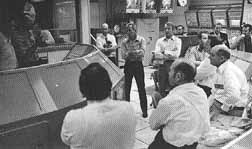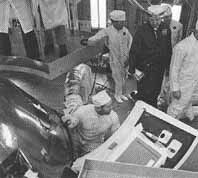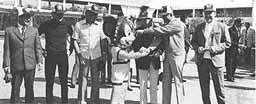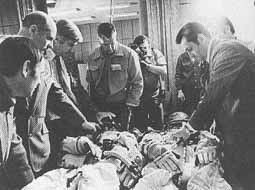
Final Round of Crew Training
While the technical specialists debated the readiness of the spacecraft, eight cosmonauts arrived in Washington on 7 February to begin their final training session in the United States. After being met in the nation's capital by Tom Stafford, the men flew to Kennedy Space Center (KSC) the next morning. Joined there by the other ASTP astronauts, the two flight teams spent all of Saturday at the launch complex. They were given briefings on the operations conducted at the facilities, and they had an opportunity to see the nearly flight-ready CSM 111 and docking module, which were in the Vehicle Assembly Building along with the launch vehicle.66
|
Alexei A. Leonov-SC |
Valeriy N. Kubasov-FE |
|---|---|
|
|
|
|
|
|
|
|
|
|
|
|
|
|
|
|
|
|
|
|
|
On Sunday, the 14 men visited Disney World. Like other tourists, the cosmonauts and astronauts rode a number of the rides in the amusement park, including one that featured miniature spaceships. After a trip on a Mississippi river boat and handshakes with Donald Duck and a space-suited Mickey Mouse, they left for the Kennedy Space Center, as Br'er Bear waved good-bye to the visitors.67
After a second day at the Cape, the crews flew to Houston. Tuesday morning was occupied by a welcoming ceremony and then briefings on the joint scientific activities planned for the flight. During the afternoon, the crews were given an update on contingency plans covering possible emergency situations.68 The two teams practiced all the joint flight activities in the Apollo, Soyuz, and docking module mockups, using the latest version of the onboard flight documents. While the prime crews did their walk-through, the backup crews practiced in the simulator. Later, as the prime crews rehearsed communication techniques, their backups practiced the joint activities. This training pattern continued into the weekend. After taking Sunday off, the crews got back to work on Monday, rehearsing the joint activities step by step until Friday the 28th.69
Each member of the prime crew completed 61.5 hours of language training during the February sessions. While the greater emphasis was placed on the joint phase, the men also found time to meet with the press and work out in the gym. Leonov and Kubasov tried out the American meals they would eat during their visit to Apollo.70 Their individual menus looked like the sample in the box at the top of the paragraph. But the visiting Americans might find something different awaiting them aboard Soyuz. (See box below.)
|
Tom Stafford-CDR |
Vance Brand-CMP |
|---|---|
|
|
|
|
|
|
|
|
|
|
|
|
|
|
|
|
|
|
|
|
|
[280] A month and a half later, the crews met again, this time in the Soviet Union. From 14-30 April, the astronauts followed a pattern of activities similar to their Houston training. They practiced transfer and other joint phases of the flight in the Soyuz mockups and worked on numerous contingency situations in the Soyuz simulator. Radio communications skills were polished while "flying" the rendezvous and docking simulators. Two of the highlights of the trip for the Americans were the visit to the mission control center at Kaliningrad on 19 April and the journey to Baykonur Cosmodrome on the 28th. At the Soviet launch center, the U.S. team saw the actual flight hardware as well as the primary launch pad, which was about 2 kilometers distant. When they returned to the States in May, the U.S. crew told the press about what they had seen.71
The airfield they had flown into served Leninsk, the modern city of 50,000 built in the desert of Kazakhstan to provide living quarters and logistical support to the space projects at Baykonur. While they did not get exact information on the size of the center, Stafford's visual impression was one of vastness. On their evening flight back to Moscow, the crews saw the lights on launch pads and related complexes for more than 15 minutes, and according to Stafford, "that makes Cape Kennedy look very small."
At one point in the press session, Jules Bergman of ABC News broke in. It had been one of his "pet peeves for years" that the Soviets kept calling their launch complex the Baykonur Cosmodrome.
Baykonur, if you'll look on the coordinates, is 135 miles [217 km] away or something. Tyuratam may only be a railhead, but it is the Tyuratam Launch Complex. They call it Baykonur, I know. . . . I'm going to call it Tyuratam. ABC is going to call it Tyuratam. SAC [Strategic Air Command] calls it Tyuratam. Can we once and for all straighten that out and arrive at a . . . name for it, Tom?72
Although Bergman thought that calling the facility Baykonur was like referring to KSC as the "Tampa Space Port," as he put it, Stafford told him that Tyuratam was only "a little bitty old city" that butts up to the new city called Leninsk. Many reporters thought that the Soviets were calling it Baykonur to hide its true location, but Slayton told them that if they really wanted to use the name the Soviets commonly used, they would have to say Baykonur. Indeed, it appeared that the entire area was called Baykonur, much as Texans would talk about the Panhandle or the Gulf Coast.*
Another source of questions from the reporters was the aborted Soyuz launch of 5 April. All the American crewmembers repeated the assurances...
 | |
|
Above, ASTP crewmen are briefed on Apollo-Saturn automatic checkout equipment during a three-day inspection tour at the Kennedy Space Center, 8-10 February 1975. Right, Alexei Leonov enters the Apollo command module being readied for the joint mission. Below, Tom Stafford playfully tweaks Mickey Mouse's nose at Disney World, Florida. Fellow sightseers are (left to right) V. N. Kubasov, Deke Slayton, Vance Brand, A. A. Leonov, and V. A. Shatalov. |
 |
 | |
|
|
|
|
In April 1975 American ASTP crews tour the Soviet Mission Control Center at Kaliningrad during the final pre-flight training session in the Soviet Union.(Soviet Academy of Sciences photo). At right, Cosmonaut Aleksandr Ivanchenkov explains the operation of the Soviet space suit to Astronauts Bean, Stafford, Cernan, and Overmyer during the crew visit to Baykonur (Soviet Academy of Sciences photo). |
[282] ...given earlier by Glynn Lunney that the upper stage failure reported by the Soviets would have no effect on ASTP. The two technical directors had briefly discussed the matter on 8 April over the telephone. The launch vehicle that had failed was one of the earlier models of the basic booster. For ASTP, a newer vehicle with a higher thrust capacity for weight would be used, and that booster had a successful launch history. Bushuyev promised Lunney full details on the "Soyuz anomaly." The astronauts were not worried about its impact on the flight; after all, the Soviets had a second spacecraft and launch vehicle set aside in the unlikely event of a repetition of the problem.73
Nick Chriss of the Los Angeles Times asked Stafford if he would be "satisfied with the type of automatic abort system they have, since the two [cosmonauts] almost landed in China." The astronaut replied that it had performed as it was supposed to; it had saved the cosmonauts' lives. If an American crew ever had to use their abort system, it might put them down in the "mid-Atlantic or the far-Atlantic Ocean," but wherever it put them the important thing is for the system to work. Stafford and Brand once again said that they were genuinely satisfied with the flightworthiness of Soyuz.74
The American crew was not particularly concerned about the 5 April Soyuz "anomaly," but Senator Proxmire was. Three days after the failure, he had requested "that the Central Intelligence Agency (CIA) make a safety assessment of the Soviet manned space technology in view of the failure of another Soviet space mission . . . and the pending U.S.-U.S.S.R. Apollo-Soyuz joint project." He told fellow senators that the "in launch failure . . . reinforces my deep concern that the upcoming . . . experiment may be dangerous to American astronauts." He did note that NASA claimed that the mission would be as safe as any other flight in the Apollo program and that they had produced a mass of studies to back up this assessment. But the senator from Wisconsin disagreed with their conclusions, saying "The history of the Soviet manned program shows an appalling lack of consistency. As soon as one severe problem is solved another occurs." Proxmire presented a box score of Soviet failures:
Since April of 1967, the U.S.S.R. has conducted 18 manned Soyuz flights. Of these, two have been catastrophic failures with loss of four lives. In addition, two other flights, Soyuz 10 and Soyuz 15 have had docking problems and cannot be considered successes. Most recently was the launch failure of what would have been Soyuz 18. Thus, five out of 18 Soyuz flights have been marred by some sort of failure.75
Given this "poor track record," Proxmire wanted the CIA to investigate the Soviet program and report to the HUD, Space, and Science subcommittee well in advance of the July launches.
[283] As Senator Proxmire worried about the safety of Soyuz, the astronauts returned to their daily training routine. Stafford, Slayton, and Brand participated in the second session of a three-part series of intercontrol center simulations. On the morning of 13 May, 1 hour before the projected launch time of Soyuz, the simulations began. For over 25 hours into a simulated mission, the Soviet and American ground controllers and flight crews rehearsed both launches and made a number of the scheduled maneuvers. Beginning on the 15th, the two teams conducted a 56-hour continuous simulation that covered the period from 47 hours, 10 minutes, to 103 hours ground elapsed time following the Soyuz launch; rendezvous, docking, crew transfers, undocking, second docking, and final separation were rehearsed. Four days later, on the 20th; a 9-hour rerun of the rendezvous and docking exercise was performed. This training gave the control center personnel and the crews another chance to check out plans covering emergencies that might arise during the flight.76
Before the final simulation - 29 June to 1 July a major meeting took place in Moscow. Coming at the end of the last plenary gathering of the Working Groups, the Joint Flight Readiness Review chaired by V. A. Kotelnikov and George Low represented the final preflight evaluation. Once Kotelnikov and Low agreed that the spacecraft were ready to be flown, the two teams could attend to the final details - preparing the launch vehicles, as the clock ticked off the remaining hours to launch. Crew training would continue up to the very last day, the real test of their efforts coming on the 15th of July.
* With an area of 2,756,000 square kilometers, Kazakhstan is the largest of the union republics, second only to the Russian Soviet Federative Socialist Republic. Even Texans would be staggered by the size, since it is nearly four time larger than the Lone Star State.
66. NASA News Release, JSC,75-07, "Cosmonauts in U.S. for ASTP Training," 6 Feb. 1975; NASA, KSC, "News Clippings; Visit of Apollo Soyuz Test Project Cosmonauts and Astronauts," 8-10 Feb. 1975; and data supplied by Donalyn Epstein (handouts, briefing materials, and itineraries) from visit to KSC.
67. Viktor K. McElheny, "Soviet Astronauts Enjoy Flight into Fantasies of Disney World," New York Times, 10 Feb. 1975; and "Detente in Space," New York Times, 15 Feb. 1975.
68. "Status Report No. 1, Joint ASTP Crew Training," 12 Feb. 1975; and data provided by Brzezinski.
69. "Status Report No. 2, Joint ASTP Crew Training," 12 Feb. 1975; and "Status Report No. 7, Joint ASTP Crew Training," 24 Feb. 1975.
70. "Minutes of the Astronaut and Cosmonaut Joint Training Visit at the Johnson Space Center," 7-28 Feb. 1975; and TWX, Lunney to Bushuyev, 7 Jan. 1975.
71. "Minutes of the Training of Soviet and American ASTP Crews at Gagarin Cosmonaut Twining Center," 14-30 Apr. 1975. In addition to the prime and backup crewmen, the four support crewmembers and Cernan went to the U.S.S.R. on this trip.
72. NASA Press Conference, JSC, "ASTP Crew Press Conference," 14 May 1975; "First Map of Baikonur Cosmodrome," Defense/Space Daily, 16 Apr. 1975; "New Map of Baikonur Cosmodrome," Defense/Space Daily, 17 Apr. 1975; Hal Piper, "Astronaut Describes Huge Soviet Center," Baltimore Sun, 15 May 1975; Thomas O'Toole, "Astronauts Tell of Huge Soviet Spaceport," Washington Post, 15 May 1975; and Ivan Borisenko, "The Baikonur Cosmodrome," Sputnik, (Apr. 1975); pp. 68-71. In F. Dennis Williams, memo to distribution, "Soviet Place Names for ASTP," 17 Apr. 1975, the Office of International Affairs took the following stance: "Soviet launch site: the Soyuz spacecraft will be launched from the Baykonur cosmodrome (also acceptable: Baykonur launch facility or Baykonur launch complex or Baykonur launch center) near the city of Tyuratam at about 40°N., 63°E. in the Kazakh Soviet Socialist Republic. Precise references should include both the name of the facility and the nearest city: That is, Baykonur launch complex near Tyuratam. This (cf. Johnson Space Center, Houston) will avoid confusion that might wise from the fact that there is a well-known city called Baykonur (about 48°N., 66°E.) some 200 miles to the northeast of the launch complex. Since both Soviet and U.S. newsmen frequently use only Baykonur, confusion about the physical location of the launch site might arise, a confusion which can best be avoided by use of the complete phrase: e.g., Baykonur launch facility near Tyuratam." In an interview, Reinhold H. Dietz-Ezell, 4 June 1975, Dietz emphasized the point that during the Working Group 4 tests at the launch site in May 1975 the Soviets used the work "Baykonur" to name the whole region surrounding Leninsk.
73. NASA News Release, JSC, 75-21, "USSR USA Discussions on Soyuz Launch Failure," 8 Apr. 1975; "Minutes of the ASTP Telephone Conversation [US Minutes]," 8 Apr. 1975; and Epstein, "Non-successful Launch of Soyuz, from Telecon, April 8, 1975," 9 June 1975.
74. NASA Press Conference, JSC, "ASTP Crew Press Conference," 14 May 1975; "Soyuz Off-Course, Mission Aborted," Washington Post, 7 Apr. 1975; James F. Clarity, "Soviet Space Shot with 2 Men Fails," New York Times, 7 Apr. 1975; Thomas O'Toole, "Soyuz Mishap May Peril Joint Project," Washington Post, 8 Apr. 1975; O'Toole, "Soyuz Failure Termed No Threat to Project," Washington Post, 9 Apr. 1975; and U.S. Congress, Senate, Congressional Record, 94th Cong., 1st sess. (9 Apr. 1975), vol. 121, p. 55537.
75. News release, issued by the office of Senator William Proxmire, Wisconsin, 8 Apr. 1975. Bushuyev in Soyuz i Apollon, pp. 27-28, commented:
Sometimes members of the American press gave the impression that they intentionally create a tense atmosphere with their questions on the safety of the joint flight. . . . Senator Proxmire also did not fail to add some fuel to the fire. He openly expressed concerns about the American astronauts life during the joint flight. In the second half of 1974, . . . Proxmire wrote a special letter to NASA Administrator, James C. Fletcher, requesting that he personally check out all of the factors related with the Soyuz/Apollo project and take the necessary steps to guarantee the safety of American astronauts.
To us, the participants of the project, it was perfectly clear that these artificially formed cautions had no foundation. The successful joint flight of the spacecraft Soyuz and Apollo confirmed this. . . . In spite of the concerns expressed by various prophets of doom on the subject of such adventure the first international space flight of Soviet and American spacecraft was crowned with success.
76. For information on
the first inter-control center simulations held in Mar. 1975, see
Charles R. Lewis, memo to distribution, "Report on the March 1975
Joint Training Simulations," 7 Mar. 1975; and Linda N. Ezell, ASTP
Narrative History Log Note 40, "Simulation Debriefing," 24 Mar. 1975.
NASA News Release, JSC, 75-42, "Moscow/Houston Control Centers to
Conduct Joint Apollo-Soyuz Simulations," 9 May 1975; and TWX, Lunney
to Bushuyev, 3 June 1975.
Next

